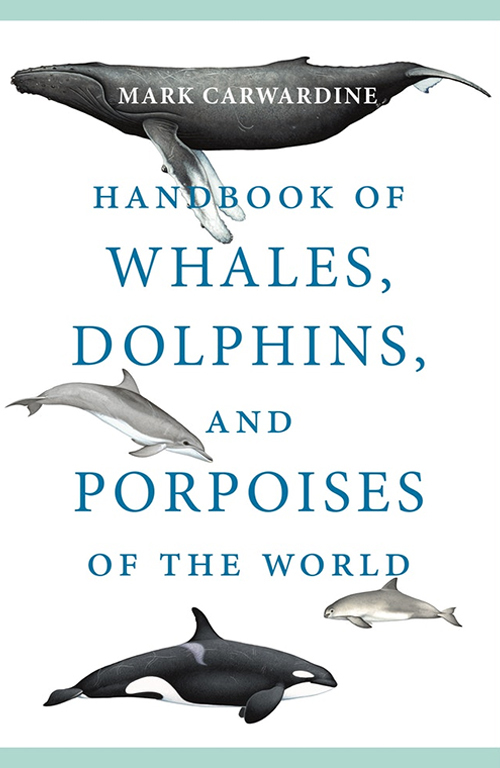Handbook of Whales, Dolphins and Porpoises of the World
By Mark Carwardine

Photo: Handbook of Whales, Dolphins and Porpoises of the World
The much anticipated new Handbook of Whales Dolphins and Porpoises by Mark Carwardine arrived earlier this year and so many of my friends and colleagues purchased a copy immediately. That has to be testament to the high regard that Mr Carwardine is held within both conservation circles and the whale watching industry. His previous handbook was publishedin 1995 and has been a friend and source of information for many of us for some years but it is fair to say that it is now a little dated. A huge amount has changed in our scientific understanding of these animals since the original publication. Including the reality that some species, such as the Yangtze dolphin are now extinct and other’s like Deriniyagala’s beaked whale and Omura’s whale have been newly described.
Let me make one thing clear: Carwardine’s new book is only about whales, dolphins and porpoises (cetaceans), and looks at all the ninety odd species found worldwide. There are other excellent handbooks and field guides that cover the full range of marine mammals, including Shirihai and Jarretts’ bestselling Whales, Dolphins and Seals: A Field Guide to the Marine Mammals of the World. There are also others that are specific to geographical areas. Despite focusing exclusively on cetaceans, Carwardine’s new book is twice the size of other field guides and the wealth of information is extensive. It is also twice the weight which can be important if, like me, you are used to climbing on and off boats, ships and planes lugging a backpack and heavy camera gear. But that extra weight is easily offset by the level of scholarship that is found within the book’s encyclopaedic pages.
It is possible that the sheer amount of facts and information could be slightly off putting for anyone new to whale watching and there are less complex guides available but even a beginner will find the identification characteristics useful and this book allows for a degree of development which will set the reader in good stead for many years to come. Cetaceans can sometimes be surprisingly difficult to identify and as wide an understanding of their different behaviours, ranges and attributes as possible is definitely useful. The book utilises the most up to date scientific work on individual species and their distribution.
The illustrations by Martin Camm are beautiful as well as anatomically detailed and they are supplemented by some exquisite photographs. Little touches like having a quick ID guide in the introduction, divided into each ocean area, are clever as is the particularly useful ID guide profiling bow-riding dolphins and porpoises from above. I can’t think of a cetacean field guide with a more considerable and thorough range of identifying features to help the observer at sea. If there is a detail particular to an individual species it is often listed like therange of beak colourations for white-beaked dolphins. I have already personally made use of the handbook when a team thatI was part of from the charity ORCA recorded two beaked whales at sea off the Canary Islands in January this year. Beaked whales are notoriously difficult to identify without clear photographs of the beak and teeth which we had been unable to get and there were at least four possible species. However, we did have photos of their backs and one of them had visible dark, short vertical stripes on the centre of the back. Carwardine’s handbook shows the existence of these bands in some female Gervais’ beaked whales. None of us had seen them listed in other field guides and as a result of this feature we were able to make a positive identification in the field.
There is so much extra content to be found in the book. For example, I love the table that shows how to age a grey whale calf and also the attempt to hypothetically assess where the historical range of the grey whale, now extinct in the North Atlantic, would have been. Similarly, our understanding of the distribution of most species has expanded massively since 1995 but is still full of significant gaps. Carwardine has attempted to suggest possible areas for species that we are short of data on like a possible wintering range for the Antarcticpopulation of blue whales. It also includes an information section for those working at sea and even conversion tables at the back for moving between imperial and metric measurements – a bonus for marine guides, educators and surveyors and whose work might move between US centric regions and the rest of the world.
Whatever your level of interest in whales, dolphins and porpoises there will be something relevant to you in this handbook and I can’t recommend it enough. But for me the most quirky and exciting section is the one on whale lice and barnacles - I’m sure you will understand that that in itself is a Cetacean Freak’s dream!